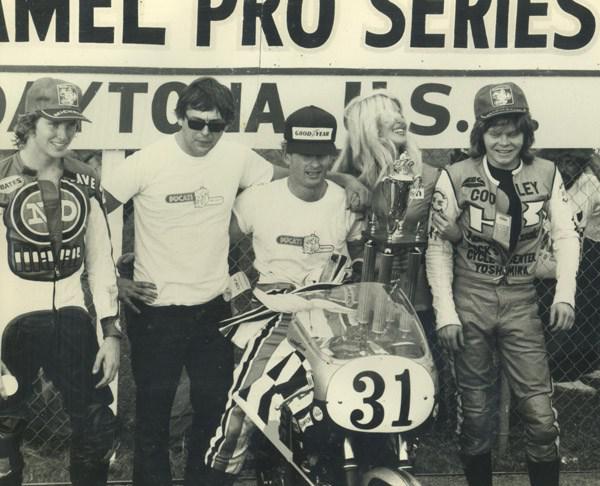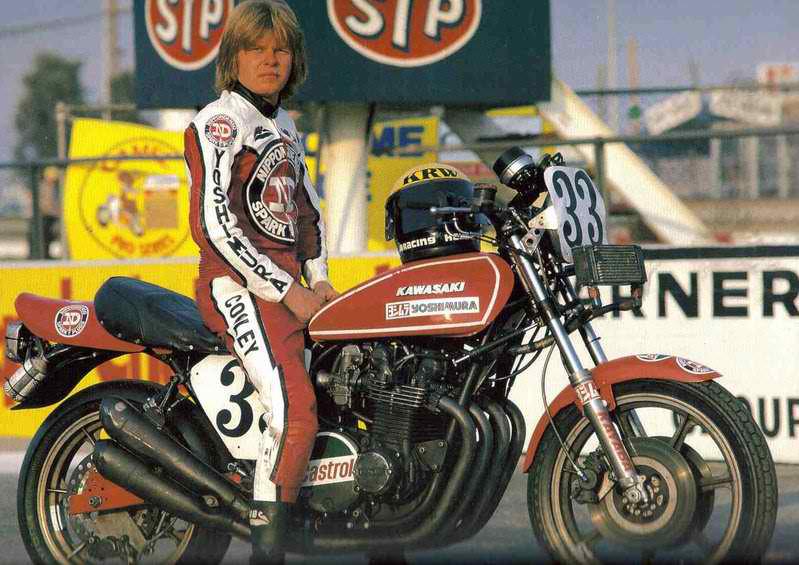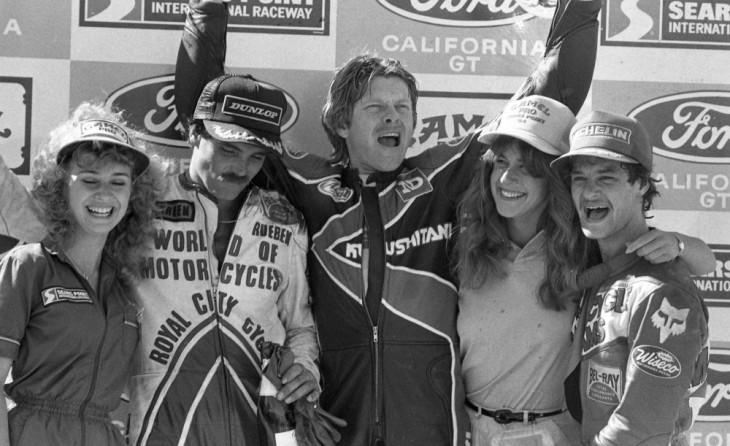
No longer was it en vogue to ride with a smooth, European style. Cooley came in with rear tire smoking and front wheel in the air, forcing his will upon bikes that weren't made for the racetrack. He changed the face of the new Superbike class. Cooley won two AMA Superbike Championships in 1979 and 1980. He gave Suzuki its first AMA Superbike title in 1979.
Wester Steven Cooley was born in Los Angeles on June 28, 1956. He came out of Southern California club racing where his father, a former racer, ran a club racing organization. Cooley honed his skills on small Grand Prix bikes before being hired by Yoshimura to compete in Superbike aboard Kawasaki's KZ1000. Pops Yoshimura built a very fast motor, but the handling of the big KZs was notoriously bad.
In the very first AMA Superbike Series race at Daytona International Speedway in March of 1976, Cooley rode the Kawasaki to a fourth-place finish despite the machine's propensity for trying to shake Cooley off his saddle at top speed around Daytona's high banks. A year later, Kawasaki returned with a bike that handled marginally better and Cooley made it to the podium for the first time with a solid third-place finish.

The final AMA Superbike race of the 1977 season was on October 2, at Riverside, California. Cooley knew the circuit well, having turned in hundreds of laps club racing there. Cooley rode the Kawasaki to his first victory that day after a good battle with the Ducatis of Cook Neilson and Paul Ritter.
Yoshimura began working with Suzuki in 1978. The GS1000, while no more powerful than the Kawasaki, was a much better handling motorcycle. Cooley picked up wins at Pocono and Laguna Seca that year.
In 1979, Cooley, riding for Suzuki, was part of the company's sweep of the Daytona Superbike event. Ron Pierce won, Cooley was second and David Emde was third, all three riding Suzuki GS1000s. Cooley didn't win a race that season, but finished on the podium at every race and edged out Pierce, and a young new Kawasaki rider named Freddie Spencer, for the title.
The 1980 season turned out to be one of the most hotly contested series, and proved to be a turning point in Superbike history. It was a battle between three riders on three different brands: Cooley on Suzuki, Eddie Lawson on Kawasaki, and Spencer now on Honda. AMA Superbike was quickly becoming the premier series in AMA road racing.
The battle that year went back and forth among the three riders. After New Zealander Graeme Crosby won at Daytona that year on a Suzuki, Lawson gained the advantage with a win at Talladega. Cooley came through with a victory in round three at Charlotte. But then Cooley went through a dry spell and watched as Lawson and Spencer traded Superbike wins for the next five races. If Cooley were to win his second title he would have to win the final two rounds, and win he did.
Cooley defeated Lawson and Mike Baldwin at Road Atlanta, then closed out the season by besting Spencer at Daytona to win the championship. It was one of the strongest endings to a season in the history of AMA racing and raised Cooley to superstar status in American road racing.

In addition to his Superbike exploits, Cooley also made history by becoming the first rider to win an AMA Formula One National on a four-stroke. It was at Road America in Elkhart Lake, Wisconsin, one of Cooley's favorite tracks, where he rode a specially built Suzuki GS1000-based F1 bike to a win over the dominant two-stroke GP machines of the era. Cooley would go on to win two more AMA F1 Nationals on big 1,000cc four-stoke bikes.
Cooley had a great relationship with Yoshimura Suzuki owner Pops Yoshimura.
"Pops was not only amazingly gifted as a tuner, but I don't think I ever knew anyone in racing that worked as hard as Pops did," Cooley said. "I felt as happy winning the Superbike championship for Pops as I did for myself."
Not only had Cooley become a racing icon in America, his reputation also grew internationally when he and teammate Mike Baldwin rode a Suzuki GS1000 to victory in the inaugural Suzuka 8 Hour Endurance race in 1978. Cooley came back two years later and won the famous race again for Suzuki, this time with New Zealander Graeme Crosby.
Cooley is considered a motorcycle racing legend in Japan for his accomplishments at Suzuka.
Cooley opened the 1981 season with a victory in the Bell Superbike 100, but the Lawson vs. Spencer duel for the championship, which Lawson won, overpowered Cooley and Suzuki that season. Cooley finished third in the final 1981 AMA Superbike standings.
The Kawasaki/Honda battles continued to overshadow Suzuki's efforts in 1982. Even though he earned four podium finishes that season, Cooley finished fourth in the series due to a number of mechanical problems throughout the season with his new Katana-based Suzuki. He finished a close third in the final Formula One Series standings behind Mike Baldwin and Steve Wise. The 1982 season ended, temporarily at least, his fine run with Suzuki, the manufacturer he will always be associated with.
Kawasaki signed the former champ for the 1983 campaign. Cooley was competitive from the start, but more mechanical gremlins and a crash resulting in a broken elbow cost him any opportunity for a title chase. Despite the problems that kept him out of a slew of races, Cooley still managed six podium finishes and seventh place in the final standings.
Cooley returned to Yoshimura Suzuki in 1984 and signed a "California only" Superbike contract. In a unique arrangement, he was also racing AMA Formula One with Honda support. Cooley made the best of his California Superbike rides. He actually crossed the line first at Laguna Seca, but a red flag came out and scoring was backed up one lap and Cooley was credited with second before being disqualified when his Yoshimura Suzuki was found to be a few pounds under the 390-pound limit in a post-race inspection. Nevertheless, Cooley came back from the Laguna disappointment and scored three podium finishes, including a victory in the August Sears Point Superbike race. It marked an end to a three-year drought in the AMA Superbike Series for Cooley, but ultimately proved to be the likeable Californian's final national win.
In May of 1985, at Sears Point, Cooley sustained life-threatening injuries. He crashed at a high rate of speed into a hillside that rose up on the outside of Turn One. Cooley made a slow, but steady recovery from the horrible accident. He actually came back to race a few more AMA Superbike races in the late-1980s and scored a couple of top-10 finishes, but he never recaptured the speed he had before his accident.
"I think physically I was able to go as fast as I had before," claimed Cooley. "But I lost that mental edge that it takes to run at the highest level of racing."
Cooley went on to teach in a popular riding school for a few years, and later earned a nursing degree. When inducted into the Hall of Fame, he was working as a medical professional in Idaho. He said he decided to work in the medical field during his recovery from the 1985 accident.
Cooley will always be remembered for changing the face of AMA Superbike racing in its formative years. He was also a fan favorite throughout his racing career. He often took the time after a hard day of racing to sit down and chat with admiring fans. Wes Cooley helped build AMA Superbike racing into one of the premier racing series in all of racing.













